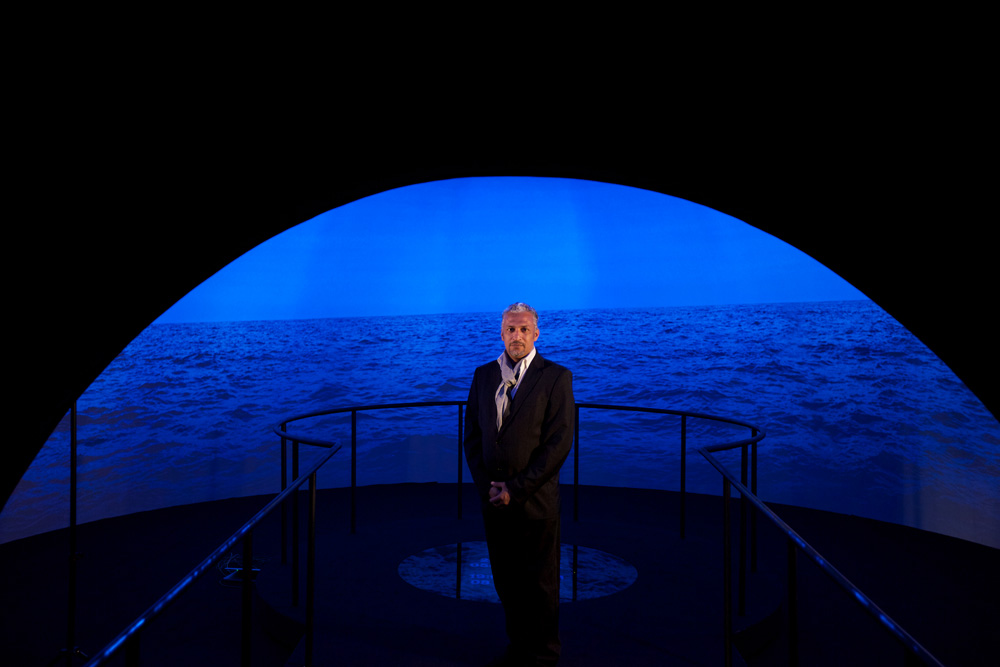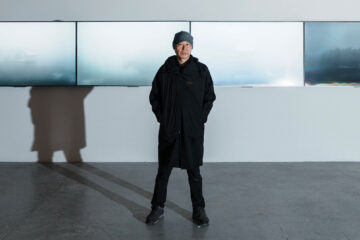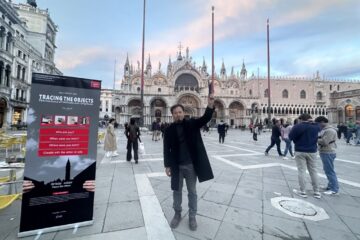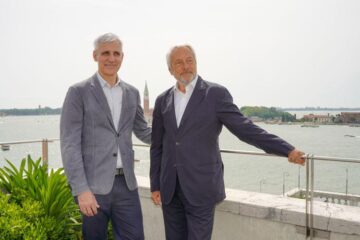WALKING ON WATER FEATURES A SPECIALLY COMMISSIONED INSTALLATION BY MOHAMMED KAZEM – UAE

WALKING ON WATER FEATURES A SPECIALLY COMMISSIONED INSTALLATION BY MOHAMMED KAZEM IN THE NEW NATIONAL PAVILION FOR THE UNITED ARAB EMIRATES
SALE D’ARMI FROM JUNE 1 – NOVEMBER 24, 2013
30 May – Venice, Italy, The National Pavilion of the United Arab Emirates (UAE), under the patronage of the Ministry of Culture, Youth and Community Development and with the support of the Sheikha Salama
bint Hamdan Al Nahyan Foundation presents “Walking on Water” for the 55th International Art Exhibition – la Biennale di Venezia. Curated by Reem Fadda, “Walking on Water” features a solo exhibition by vanguard Emirati artist Mohammed Kazem under the leadership of Commissioner, Dr. Lamees Hamdan.
ءاملا ىلع يشملا/ “Walking on Water”
Walking on Water presents “Directions 2005/2013”, a specially commissioned immersive installation, by
Mohammed Kazem, of a 360-degree projection of the sea within an enclosed chamber. The artwork recreates the experience of what it is to be lost at sea and, symbolically, to break down geographical borders and intangible barriers between people. By putting the viewers off-balance, Kazem engages them both conceptually and physically with his work, thereby inviting them to question and challenge their perceptions of openness and universality.
“Borders are imminent realities in our current ‘global’ age. Despite progress and acts of modernization, our world remains hindered with the ideas of boundaries and restrictions. Openness remains one of the phantasmal and illusive ideas of our times. The conceptual trajectory of Mohammed Kazem’s practice has constantly been to confront boundaries and limitations, be it material or natural. These symbolic acts
of breaking shackles and inhibitions are his way of asserting his humanity and existence. Through intuition and deliberation, he investigates the natural and physical restrictions, especially those of the sea,
to not only question but also assert the right to roam free; spiritually, conceptually and materially,” explains curator Reem Fadda on her selection of this work by Kazem.
Kazem makes use of artistic elements and methods that he has been working with for over 20 years, including drawing, light, color, photography and video, to create an experiential installation. Kazem worked
with iGloo Vision and Complet Films to realize this work.
Directions 2005/2013 was conceived and exhibited in 2005 as a maquette, but wasn’t realized due to
financial and technical complications of producing such a large-scale work. Part of a much larger body of work, Directions is arguably Kazem’s most emblematic conceptual series. In it, Kazem mainly utilizes Geographical Positioning System (GPS) coordinates to symbolically document his location. These coordinates have become an iconic trademark of his practice. Begun in 1999, the Directions series has continued to evolve for over a decade, all the while seeking to address political, sociological and
personal issues related to his environment.
The Curator and Artist
Fadda is currently working as Associate Curator of Middle Eastern Art – Abu Dhabi Project at the
Solomon R. Guggenheim Foundation based in New York. She is also a PhD candidate at the History of Art
and Visual Studies Department at Cornell University. From her curatorial concept, Fadda stated;
“Mohammed Kazem, a pioneering contemporary artist and thinker from the UAE, represents a generation
that emerged from an avant-garde legacy of arts and artists in the UAE and the surrounding region, one
that has thrived since the mid-70s.”
Kazem first studied art at the Emirates Fine Art Society, he then went on to learn music, attend national
and international art workshops, as well as teach painting at Dubai Art Atelier. Widely known through numerous solo and group exhibitions in the UAE and abroad, his works have been collected by private institutions, international museums and collectors. A pioneer in the UAE contemporary art scene for
his incorporation of video and new technologies, his interest in conceptual art and his progressive attitude towards medium and context is especially highlighted by his ongoing series “Directions.”
Publication
A major publication on the artist accompanies this exhibition. Featuring essays by writers: Reem Fadda, Paulina Kolczynska, Hassan Sharif, Sultan Al Qassemi and Adel Khozam, this 320 page book charts
Kazem’s practice from the 1970’s to present day. Designed by Fikra, published by the National Pavilion for
the United Arab Emirates and printed by Damiani (Bologna, Italy)
Design
Fikra is a multidisciplinary design studio specialized in bilingual graphic design: Arabic and English.
Founded
by Salem Al-Qassimi in 2006, Fikra works across a variety of media, time-based and print including book design, data visualizations, environmental graphics and bilingual typography.
Location – Sale d’Armi
La Biennale di Venezia has marked an important milestone in its long history by awarding the United
Arab Emirates, the first Gulf National to participate in the Art and Architecture Biennale, with a long-term hospitality agreement (permanent pavilion) in the Arsenale – Sale d’Armi. The agreement was finalized through the United Arab Emirates Ministry of Foreign Affairs. La Biennale di Venezia is world-renowned
for the biannual International Art Exhibition and Architecture Exhibitions, as well as the International
Film Festival, and continues the great tradition of the Festivals of Contemporary Music and Theatre, now flanked by the Festival of Contemporary Dance.
The Venice Internship Program
The third iteration of this specialized program was launched in November 2012. The specially selected candidates were drawn from the across the UAE through a nation-wide recruitment campaign. After
a rigorous screening and interview process, the selected fellows are now participating in an extensive
training program aimed at enabling them to engage fluently with the content of the exhibition in Venice.
This year, the Venice Internship Program is partnering with the prestigious Ca’Foscari University in Venice, which facilitated the inclusion of six specially selected Italian interns working side-by-side with the
Emirati fellows. This partnership has been developed to foster a true exchange of cultures between the interns and to allow Emiratis to engage further with Italian customs, language and knowledge thus
enhancing their local experience in Venice.
You can follow their developments and their blog posts on the Venice Internship Program Blog:
http://uaepavilion.wordpress.com/
Follow them also on Twitter: @veniceinterns
Location and Public Hours
The National Pavilion of the UAE is located in the Arsenale – Sale d’Armi, first floor.
The exhibition is open to the public from 1 June – 24 November, 2013
10 am – 6 pm
Closed on Monday, excluding 3 June, 18 November.
For more information and press materials visit: www.uaepavilion.org
Follow us:
Twitter: UAE_Pavilion_VB
Facebook: National Pavilion of the UAE Page
.-.-.-.
Mohammed Kazem è l’artista che rappresenta gli Emirati Arabi Uniti alla 55° Esposizione Internazionale d’Arte – la Biennale di Venezia. Intitolata “Walking on Water”, la mostra presenta un’installazione site-specific realizzata per l’occasione e concepita per occupare lo spazio del nuovo Padiglione degli Emirati nelle Sale d’Armi dell’Arsenale.
Dal 1° maggio al 24 novembre Vernissage giovedì 30 maggio alle 15.30
Finanziato dal Ministro della Cultura, dello Sviluppo della Gioventù e della Comunità, e con il sostegno della Sheikha Salama bint Hamdan Al Nahyan Foundation, il Padiglione degli Emirati Arabi Uniti presenta il lavoro dell’artista Mohammed Kazem in una mostra intitolata “Walking on Water”, sviluppata sotto l’egida del suo Commissario, la dott.ssa Lamees Hamdan, e della curatrice Reem Fadda.
“Walking on Water”
Per la loro terza partecipazione alla Biennale di Venezia, gli Emirati Arabi presentano un’installazione immersiva realizzata da Mohammed Kazem appositamente per la 55° Biennale di Venezia, ma che fa parte
del suo progetto più significativo, “Directions 2005/2013”. Un video girato in mare aperto sarà proiettato su uno schermo a 360° al fine di ricreare l’esperienza dell’isolamento in mare. Simbolicamente, Kazem cerca
di abolire le frontiere geografiche e le barriere immateriali tra la gente. Al fine di coinvolgere il pubblico nel suo lavoro, Kazem lo destabilizza in modo tale da invitarlo a mettere in dubbio la percezione che il pubblico stesso ha dei concetti di universalità e di apertura.
“Benché siamo nell’età della globalizzazione e del progresso, le frontiere geografiche sono ancora una realtà
ben presente; ed il mondo rimane ostacolato da tante barriere e restrizioni. L’idea di apertura rimane una delle più utopiche e fantasmatiche della nostra epoca. Il concetto sotteso al lavoro di Mohammed Kazem è sempre stato di abbattere le frontiere ed i limiti, sia materiali sia naturali. Questi atti simbolici, che hanno una dimensione molto liberatrice, sono il suo modo di affermare la sua esistenza e la sua umanità. I processi intuitivi e cognitivi che Kazem utilizza gli permettono di esplorare le restrizioni fisiche e
naturali del mondo – in particolare quelli del mare [che è un tema centrale della serie “Directions 2005/2013″].
Così l’artista riafferma il diritto di circolare liberamente, sia spiritualmente, sia concettualmente, sia fisicamente.”, spiega la curatrice Reem Fadda.
In “Walking on Water”, Kazem utilizza elementi artistici e metodi con cui lavora da oltre venti anni – compresi disegno, fotografia, video e luci – per creare un’installazione empirica. Per realizzare questa installazione ha anche lavorato con iGloo Vision e Complet Films.
La maquette di “Directions 2005/2013” è stata concepita ed esposta nel 2005 ma, a causa delle difficoltà finanziarie e tecniche che pone la produzione di un lavoro ad una tale scala, l’installazione non aveva potuto, fino ad oggi, essere realizzata.
Quel progetto fa parte di “Directions”, il lavoro più emblematico dell’opera di Mohammed Kazem nel quale l’artista considera principalmente delle questioni politiche, sociologiche e personali. Iniziata nel 1999, questa serie viene sempre sviluppata e riproposta con espedienti installativi differenti. Il concetto, però, rimane lo stesso: utilizzando il Geographical Positioning System, comunemente noto come GPS, Kazem documenta la sua presenza in vari luoghi, registra le coordinate riportate dallo strumento e le integra nelle
sue installazioni interattive – un processo che è diventato il suo marchio di fabbrica.
Biografie
Reem Fadda, curatrice – Attualmente Fadda vive a New York dove lavora come curattrice specializzata nell’arte del medio oriente – Progetto Abu Dhabi alla Solomon R. Guggenheim Foundation. Sta conseguendo il Dottorato di Storia dell’arte e Dipartamento di Studi Visivi alla Cornell University (Stato di New York, Stati Uniti).
“Mohammed Kazem è un pioniere dell’arte contemporanea e concettuale negli Emirati Arabi Uniti, perciò è anche rappresentativo di una generazione di artisti che si è sviluppata negli anni 70, influenzati dal retaggio culturale ed artistico della regione, in particolare quello degli Emirati.” Reem Fadda spiega così la sua scelta artistica.
Mohammed Kazem, artista – Studia dapprima arte alla Emirates Fine Art Society (Sharjah, Emirati Arabi Uniti), e poi prosegue i suoi studi artistici con la musica. Ha seguito parecchi seminari internazionali e nazionali di arte prima di iniziare ad insegnare al Dubai Art Atelier. Le numerose mostre collettive e individuali alle quali ha partecipato gli sono valse il riconoscimento sulla scena internazionale.
I suoi lavori sono stati presentati in numerose mostre individuali e collettive negli Emirati e all’estero, cosa
che gli ha procurato fama internazionale. Diverse sue opere si trovano in luoghi pubblici, musei e presso privati.
Mohammed Kazem è un pionere dell’arte contemporanea negli Emirati, principalmente per il suo utilizzo di più media così come di nuove tecnologie e per il suo interesse nell’arte concettuale – caratteristiche evidenziate maggiormente nella serie “Directions”.
Riferimento bibliografico
Una pubblicazione importante dedicata all’artista accompagna questa mostra. Questo libro di 320 pagine
comprende dei saggi brevi scritti da Reem Fadda, Paulina Koczynska, Hassan Sharif, Sultan Al Qassemi e
Adel Khozam che tracciano il percorso artistico di Kazem dagli anni 70 ad oggi. Concezione e realizzazione
grafica: Fikra (Dubai, Emirati Arabi Uniti). Stampato da Damiani (Bologna, Italia). Pubblicato dal Padiglione nazionale degli Emirati Arabi Uniti.
Design
Fikra è un’agenzia di comunicazione visiva specializzata nel design bilingue in inglese ed arabo. Fondata nel 2006 da Salem Al-Qassemi, Fikra fornisce ai propri clienti un’ampia scelta di servizi: comunicazione ambientale, tipografia bilingue e identità aziendale.
Le Sale d’Armi, la nuova residenza del Padiglione degli Emirati
La Biennale di Venezia ha assegnato agli Emirati Arabi Uniti un Padiglione permanente nelle Sale d’Armi dell’Arsenale. Con quest’accordo concluso dal Ministero degli Affari Esteri degli Emirati Arabi Uniti, essi
diventano la prima nazione del Golfo a partecipare all’Esposizione Internazionale d’Arte e la alla Mostra Internazionale di Architettura.
La Biennale di Venezia è una delle istituzioni culturali più prestigiose al mondo. Si colloca ai vertici mondiali
per la Mostra Internazionale d’Arte Cinematografica, per l’Esposizione Internazionale d’Arte e la
Mostra Internazionale di Architettura, per i Festival di Musica e Teatro, e per il più recente Festival di Danza.
Il Venice Internship Program
La terza edizione di questo programma di formazione specializzato, lanciato per la prima volta nel 2009,
ha avuto inizio a dicembre del 2012 con la selezione di 18 giovani che hanno dimostrato di avere un interesse particolare per il settore artistico e culturale. Dopo una campagna di reclutamento lanciata su
larga scala negli Emirati Arabi e un percorso di selezione rigoroso, i candidati risultati idonei parteciperanno ora a un programma di formazione volto alla loro introduzione nel mondo dell’arte e alla loro familiarizzazione con il contenuto della mostra di Venezia, dove saranno, alla fine, inviati di volta
in volta, durante i sei mesi della Biennale.
Quest’anno il Venice Intership Program si spinge ancora più lontano, associandosi alla prestigiosa università veneziana Ca’ Foscari, permettendo così l’integrazione di sei stagisti italiani nel gruppo degli Emirati Arabi. Questo partenariato è stato sviluppato con lo scopo di incoraggiare uno scambio reale
tra i due gruppi culturali e di iniziare un dialogo.






No Comment